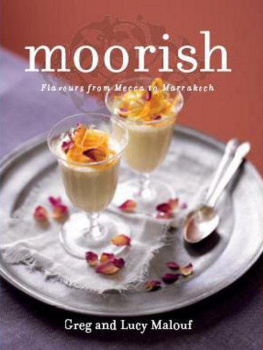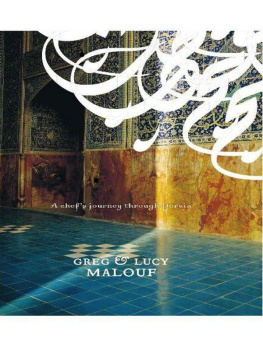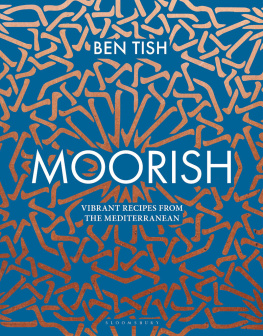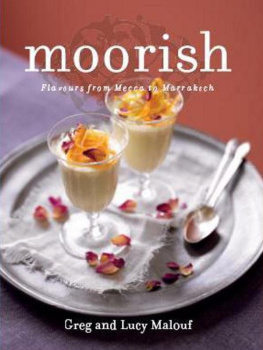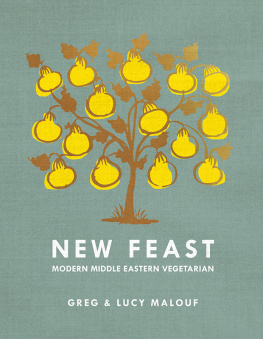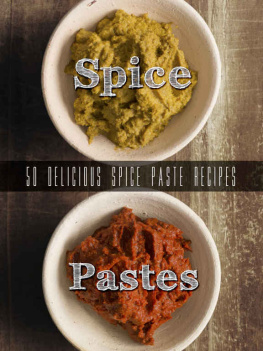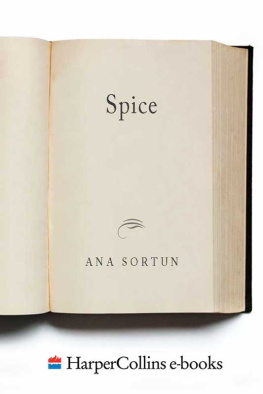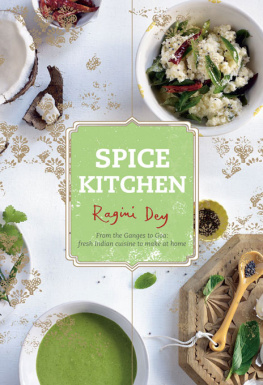


SI: please match up background on l/h page so it is the same tone as r/h page.
This edition printed in 2009
First published in 2001
by Hardie Grant Books
85 High Street
Prahran, Victoria 3181, Australia
www.hardiegrant.com.au
All rights reserved. No part of this publication may be reproduced, stored in a retrieval system or transmitted in any form by any means, electronic, mechanical, photocopying, recording or otherwise, without the prior written permission of the publishers and copyright holders.
The moral right of the authors has been asserted
Copyright text Greg and Lucy Malouf 2009
Copyright photography Mark Roper 2009
National Library of Australia Cataloguing-in-Publication Data:
ISBN 978 1 74066 741 8
Cover and internal design by Greendot Design
Cover photography by Mark Roper
Styling by Leesa O'Reilly
Typesetting by Pauline Haas
Printed and bound in China by C & C Offset Printing Co. LTD
10 9 8 7 6 5 4 3 2 1
www.gregmalouf.com.au
The publisher would like to thank the following for their generosity in supplying props for the book: Country Road, A Day in Earth, The Essential Ingredient, Hermon & Hermon, Hub, Izzi & Popo, Kasbah Moroccan Imports, Kris Coad, Manon Bis, Market Import, Moss Melbourne, Safari Living, Seneca Textiles and Steptoe & Sons
Dedicated to our mothers, May Malouf and Rosemary Rushbrooke, who instilled in us a love of good food and culinary adventure from our earliest years.
Contents

Acknowledgements
THERE ARE MANY PEOPLE TO THANK for this gorgeous new edition of Moorish . First and foremost, wed like to thank Hardie Grant for suggesting that it needed a makeover, and in particular, we thank Mary Small and Ellie Smith for their hard work in making it happen.
The books new look is the result of the creative efforts of several key people: Mark Roper took the wonderful photographs and Gayna Murphy waved her design magic wand over the pages. Leesa OReilly sourced all manner of exquisite props, which made the food look stunning. Thanks to you all for a beautiful end result. We couldnt be happier!
Wed also like to thank Odette Martini and Brooke Payne for working so hard on the photoshoot and for making sure we kept to schedule.
We are also grateful to the wonderful people who provided us with such terrific ingredients: Rima at the A1 Middle Eastern Bakery; Peter at Flavours Fruit and Veg; Roger, Simon and Sylvio at Lagos Butchers; John and George at Ocean Made Seafood; Angela at Senselle and Maria at The Vital Ingredient.
2009
We are shameless! We want to seduce you: to stimulate your imagination, invigorate your senses and tempt you to try the wonderful flavours of Moorish food.
When we wrote these words to introduce the first edition of this book in 2001, the cooking of Middle Eastern and North African countries was still relatively new and unexplored in western countries. Although nearly everyone was familiar with the depressingly ubiquitous tabbouleh and take-away falafel, that was about the extent of our understanding of these rich and complex cuisines.
Things have changed. Nowadays, ingredients such as zaatar, preserved lemons and yoghurt cheese pop up on restaurant menus around the world, and we order baba ghanoush and brik loeuf with confidence. But many of us feel that we still dont know and understand Moorish food in quite the same way that we know and understand English, Italian and French food or the more recently fashionable dishes of Asia.
This reluctance is due, largely, to a lack of resources after all, there are thousands of books on how to cook Italian food or Chinese food, but still relatively few about food from the Middle East and North Africa or even the Eastern Mediterranean. And those dishes that we are familiar with tend to belong to a limited range of strictly traditional fare.
Our clear and undisguised mission in life is for people to become as comfortable with the ingredients, techniques and dishes of Moorish food as they already are with those from the Mediterranean. We want you to be able to whip up chermoula as readily as pesto; to be as comfortable with tagines as with casseroles. We want spices such as sumac and saffron to become as much a part of your repertoire as basil and rosemary.
Thankfully, this is not about transforming your kitchen to a spice bazaar while some of the spices and ingredients might be new to you, and the odd one might require a trip to a deli or Middle Eastern grocer, most of the ingredients you need for the recipes that follow, youll already have on hand. Others are increasingly available from the local high street supermarket. What we hope to try and teach you, though, is how to use them in the best Moorish tradition, if not necessarily in traditional dishes. We want you to learn how to use what might even already be familiar ingredients in new and exciting ways, to transform the mundane into something exotic.
By Moorish, what we mean, loosely, is the cuisine that sprang up as a result of the Arabic occupation of North Africa in the eighth century.
Over the centuries, though, Moorish food has absorbed not just the exotic range of spices, herbs, fruit and vegetables introduced by the Arabs, but also the later influences of the Ottoman Empire and new and different ingredients from the New World.
This is the culinary mix that we explore in this book: a feast of dishes from Mecca to to Marrakech.

In our view, the point of difference in all good cooking comes when you can be inventive and creative; when you are comfortable enough with ingredients and dishes to throw recipes and precise measurements to the wind and start to have fun in the kitchen. When you begin to rely on your taste buds and instinct rather than slavishly following written instructions. And this is how all great cooks (and chefs) practise their art with handfuls and scoops rather than grams and millilitres.
This is no more true than in the kitchen at home. We all know the relief of being able to knock up an old favourite be it scrambled eggs, or spaghetti Bolognese or a Victoria sponge for tea. There is something wonderfully liberating about working on auto-pilot in the kitchen about having dishes in ones repertoire that almost make themselves.
It comes with practise, of course, and theres the rub. How can you be that comfortable with a cuisine that is relatively new and unfamiliar? When you dont know what things are meant to taste like? How much easier is it to stick to the old favourites? But stop for a minute and think back to the days (not so very long ago, after all) when few of us recognised the taste of lemongrass or even basil or chilli. To understand new ingredients and flavour combinations, all that is really required is a sense of adventure.
This book begins, therefore, with a section on the spice mixes, dressings, relishes, pickles and preserves that best define Moorish cooking and with these recipes we suggest that you do follow the quantities carefully, so that you become familiar with the intended flavours and textures. But from here on in, let your imagination run wild! Follow our suggestions, and use baharat, for instance, to transform a humble roast lamb, or tabil to spice up a warming lentil soup; fry a scallopini in cumin butter for a change, or braise oxtail with cinnamon and preserved lemon; make tiramisu a little different by using Turkish coffee instead of espresso, and flavour a simple pannacotta with rosewater and top with shreds of candied orange to make it truly exotic.
Next page
